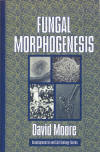Chapter 12: Development and morphogenesis
In Chapter 9 we showed how fungal hyphae are capable of a wide range of cell differentiation, and in other Chapters (particularly Chapters 3 and 8) we have mentioned and illustrated some of the variety of multicellular fruiting structures (sexual and asexual) that fungi can produce. It must be evident, therefore that a fungal mycelium has a number of alternative developmental pathways open to it:
- continuation of hyphal growth
- production of asexual structures
- progress into the sexual cycle.
These are not strict alternatives, because a mycelium of even modest size may express all of these possibilities at the same time, so we can deduce that whatever control of genetic expression is involved must be local.
In this Chapter we explain the nature of development and morphogenesis in fungi and the formal terminology of developmental biology. The observational and experimental basis of fungal developmental biology lead to the conclusion that there are ten ways to make a mushroom, depending on different arrangements of competence and regional patterning. As specific examples we show how the Coprinopsis fruit body makes hymenia, and how Coprinopsis and Volvariella make gills (not forgetting how polypores make tubes). The Coprinopsis fruit body also provides examples of the construction of mushroom stems and the co-ordination of cell inflation throughout the maturing fruit body; which leads us to consider the mechanics of the mushroom fruit body.
The mechanics depend on the biochemistry, and so we have to examine metabolic regulation in relation to morphogenesis, as well as ideas about developmental commitment, and comparisons with other tissues and other organisms. We show how classic genetic approaches allowed some progress to be made in the study of fungal development and how this has been accelerated by genomics and other aspects of global analysis of macromolecules. Finally, we turn to the end-game in development: degeneration, senescence and death, and finish with our summary of the basic principles of fungal developmental biology.
| For the price of a Coffee & Coffee
Cake ($5) you can
buy yourself a PDF file of this chapter from 21st Century
Guidebook to Fungi Online. Our PDFs feature an elegantly simple text layout that is easily readable on your mobile or other device, and all hyperlinks are live so you can continue to enjoy the Internet experience. Chapter 12: Development and morphogenesis. The following appendix items are attached to this chapter: Don Emmeluth’s Latin and Greek Derivations; Ten ways to make a mushroom; and Genomic systems analysis of fungi starter references, making a 74-page PDF file priced at FIVE US$ ($5) Delivered to you by SendOwl Not convinced yet? Download a FREE sample HERE  |
|
This is still the only book available that deals with general fungal developmental biology.Ordering details: Fungal Morphogenesis, New York: Cambridge University Press. ISBN-13: 9780521552950. DOI: http://doi.org/10.1017/CBO9780511529887.
|
Updated July, 2019

